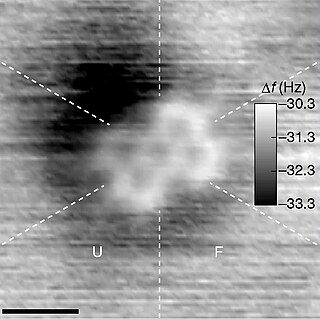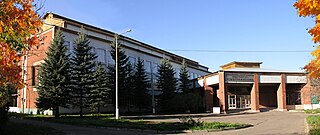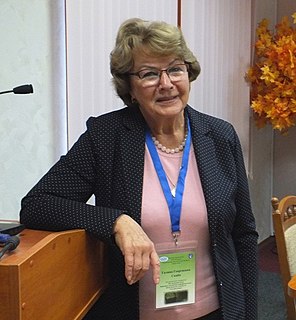
A hydrogen bond is a primarily electrostatic force of attraction between a hydrogen (H) atom which is covalently bound to a more electronegative atom or group, and another electronegative atom bearing a lone pair of electrons—the hydrogen bond acceptor (Ac). Such an interacting system is generally denoted Dn–H···Ac, where the solid line denotes a polar covalent bond, and the dotted or dashed line indicates the hydrogen bond. The most frequent donor and acceptor atoms are the second-row elements nitrogen (N), oxygen (O), and fluorine (F)

A molecule is an electrically neutral group of two or more atoms held together by chemical bonds. Molecules are distinguished from ions by their lack of electrical charge.
Quantum chemistry, also called molecular quantum mechanics, is a branch of chemistry focused on the application of quantum mechanics to chemical systems. Understanding electronic structure and molecular dynamics using the Schrödinger equations are central topics in quantum chemistry.

Adenine is a nucleobase. It is one of the four nucleobases in the nucleic acid of DNA that are represented by the letters G–C–A–T. The three others are guanine, cytosine and thymine. Its derivatives have a variety of roles in biochemistry including cellular respiration, in the form of both the energy-rich adenosine triphosphate (ATP) and the cofactors nicotinamide adenine dinucleotide (NAD), flavin adenine dinucleotide (FAD) and Coenzyme A. It also has functions in protein synthesis and as a chemical component of DNA and RNA. The shape of adenine is complementary to either thymine in DNA or uracil in RNA.

Ice Ih is the hexagonal crystal form of ordinary ice, or frozen water. Virtually all ice in the biosphere is ice Ih, with the exception only of a small amount of ice Ic that is occasionally present in the upper atmosphere. Ice Ih exhibits many peculiar properties that are relevant to the existence of life and regulation of global climate. For a description of these properties, see Ice, which deals primarily with ice Ih.
Arnold Markovych Kosevich was a Soviet and Ukrainian physicist, known for contributions to the electron theory of metals and the theory of crystals.

The Institute of Physics (IOP) of the National Academy of Sciences of Ukraine founded in 1926 is the oldest research institution of physical science within the Academy. Being on the path of both infrastructure development and research diversification for more than 80 years, the Institute has eventually originated five more specialized research institutions.
In chemistry, ice rules are basic principles that govern arrangement of atoms in water ice. They are also known as Bernal–Fowler rules, after British physicists John Desmond Bernal and Ralph H. Fowler who first described them in 1933.

The National Science Center Kharkiv Institute of Physics and Technology (KIPT) is the oldest and largest physical science research centre in Ukraine. Today it is known as a science center as it consists of several institutes that are part of the Kharkiv Institute of Physics and Technology science complex.

The Institute of Spectroscopy Russian Academy of Sciences (ISAN) is a Russian research institution located in Troitsk, Moscow
Emmanuel I. Rashba is a Soviet-American theoretical physicist of Jewish origin who worked in Ukraine, Russia and in the United States. Rashba is known for his contributions to different areas of condensed matter physics and spintronics, especially the Rashba effect in spin physics, and also for the prediction of electric dipole spin resonance (EDSR), that was widely investigated and became a regular tool for operating electron spins in nanostructures, phase transitions in spin-orbit coupled systems driven by change of the Fermi surface topology, Giant oscillator strength of impurity excitons, and coexistence of free and self-trapped excitons. The principal subject of spintronics is all-electric operation of electron spins, and EDSR was the first phenomenon predicted and experimentally observed in this field.
Kirill Borisovich Tolpygo, also known as K. B. Tolpygo, was a Soviet physicist and a corresponding member of the National Academy of Sciences of Ukraine. He was recognized for his works on condensed matter theory; the theory of phonon spectra in crystals; electronic structure and defects in insulators and semiconductors; and biophysics. He created the Department of Theoretical Physics and the Department of Biophysics at Donetsk National University. Tolpygo was a teacher, mentor and scientific adviser to graduate students. Tolpygo was awarded the Order of the Great Patriotic War.
Walter Gordy, was an American physicist best known for his experimental work in microwave spectroscopy. His laboratory at Duke University became a center for research in this field, and he authored one of the definitive books on the field.

Geraldine Lee Richmond is an American chemist and physical chemist who is President Joe Biden's nominee to serve as Under Secretary of Energy for Science in the US Department of Energy. Richmond is the Presidential Chair in Science and Professor of Chemistry at the University of Oregon (UO). She conducts fundamental research to understand the chemistry and physics of complex surfaces and interfaces. These understandings are most relevant to energy production, atmospheric chemistry and remediation of the environment. Throughout her career she has worked to increase the number and success of women scientists in the U.S. and in many developing countries in Africa, Asia and South America. Richmond has served as president of the American Association for the Advancement of Science, and she received the 2013 National Medal of Science.
Antonina Fedorovna Prikhot'ko, was a Russian-born Ukrainian Soviet experimental physicist. She was an Academician of the National Academy of Sciences of Ukraine and is known for her fundamental contributions to the condensed matter spectroscopy.
Vladimir L'vovich Broude, was a Soviet experimental physicist of Jewish descent. His father was a Professor of biochemistry and his mother was a medical doctor. His elder brother Evgenii was conscripted soon after beginning of the Nazi invasion in June 1941 and lost his life.
Chunni Lal Khetrapal is an Indian chemical physicist and a former vice chancellor of Allahabad University. He is known for his studies chemical physics, particularly in the field of Nuclear magnetic resonance spectroscopy. He is an elected fellow of the Indian National Science Academy and the National Academy of Sciences, India. The Council of Scientific and Industrial Research, the apex agency of the Government of India for scientific research, awarded him the Shanti Swarup Bhatnagar Prize for Science and Technology, one of the highest Indian science awards, in 1982, for his contributions to chemical sciences.
Zvyagin Anatolii Illarionovich – physicist-researcher, Doctor of Sciences, Professor, Corresponding Member of the Academy of Sciences of the Ukrainian SSR, the State Prize of the Ukrainian SSR in Science and Technology, director of the Institute for Low Temperature Physics and Engineering (1988-1991). He is known as the author of pioneer studies of dynamical, magnetic, and thermal properties of low-symmetric and low-dimensional magnetic insulators.

Galyna Grygorivna Skibo - Ukrainian scientist, doctor of medical sciences, professor, corresponding member of the National Academy of Sciences of Ukraine (2018), laureate of the awards of the National Academy of Sciences of Ukraine named after O.O. Bogomolets (1996) and P.G. Kostiuk (2019), winner of the State Prize of Ukraine in the field of science and technology (2013), Honored Worker of Science and Technology of Ukraine (2006), head of the Cytology department of the Bogomoletz Institute of Physiology NAS of Ukraine, professor of NSC "Institute of Biology and Medicine" of Taras Shevchenko National University of Kyiv.









